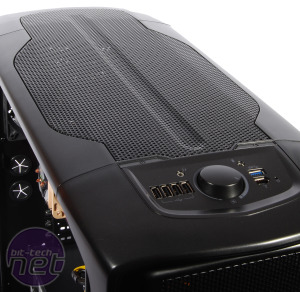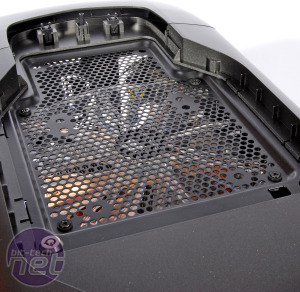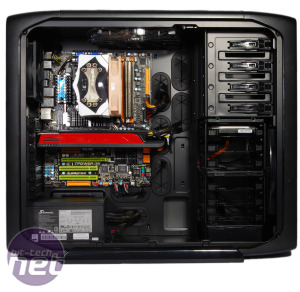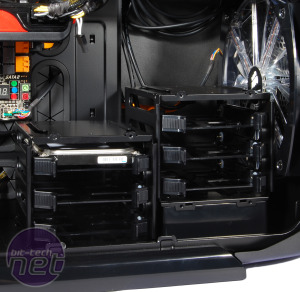
Performance Analysis
We strapped our test gear into the 600T, which proved to be a simple and stress free task, and fired up our usual thermal stress tests. The temperatures were recorded with the movable drive bays in their default configuration as it’s our policy to test cases in their stock configuration.The 600T cooled our CPU down to a delta T of 54oC regardless of the speed at which the fans were set; this is a fairly mediocre result. There are a number of possible reasons for this, one of which is the location of the roof fan. This fan is further towards the front of the case than we’re used to seeing and looks like it could actually be suffocating our CPU cooler of the cool air the intake is pulling in from outside of the case. A second reason could be that the two 200mm fans just don’t shift an awful lot of air due to their shallow blade pitch. This is a problem for the front intake fan as, with the drive bays oriented perpendicular to it, it doesn’t have the power to push much air into the case.
Our graphics card also ran slightly warmer in the 600T than we’re used to seeing with a delta T of 47oC at minimum fan speeds and of 46oC at maximum fan speeds. This isn’t a disastrous result, as the card was still well within its operating parameters, but it does indicate that the 600T doesn’t supply as much cool air to the graphics card area of the case as other chassis we’ve tested.
Again the weedy front fan has to take some blame, but it’s also worth noting the 600T doesn’t have the side panel fan (or a grille for a side panel fan) that a lot of other cases use to get cool air to this area of the case. This does mean that the 600T can suppress more of the noise made by your PC, however.
We experimented with moving the drive bays around to see if we could improve the cooling of the 600T, and things did improve when we moved the middle drive bay down to its mount on the floor of the case. This knocked another degree off the delta T of the graphics card and didn’t compromise storage capacity; the CPU delta T remained constant however.
Our testing also revealed the fan controller that sits atop the case to be something of a disappointment. We saw barely any difference between its maximum and minimum settings, either in the noise of the fans it controlled or their rotational speed. These observations were backed up by our testing, as we found no difference in CPU delta T and only a 1oC change in GPU delta T when we changed from the minimum to the maximum speed setting.
Conclusion
It’s tough to make a call on the 600T. Its styling was a hot topic of conversation in the office, and the eventual overriding feeling was that it looked a little on the tubby side. The heavy use of plastic also put some members of the team off as while the underlying framework is solidly built, the plastic that surrounds it wasn't as reassuring.The innards of the 600T are difficult to fault though. Cable routeing is a doddle and the interior looks good and is well put together. The movable hard disk caddies are also a nice touch, as are the washable dust filters. Cooling performance was a little worse than average due to the weak, ineffectual fans, but the case is quiet in operation.
If you like the styling of the 600T then it’s worth a punt, as it's pretty good. However, we can't help but feel let down by a few of the additions - the fan controller should have been great, but didn't have much effect, while a little more space between the motherboard and the ceiling of the main chamber would have let us fit a standard radiator instead of a skinny one. The main issue for the 600T is the SilverStone Raven RV02, which costs £30 less and has superior cooling with the same level of quietness - we'd rather have the Raven than the 600T any day.
- Cooling
- x
- x
- x
- x
- x
- x
- -
- -
- -
- -
- 6/10
- Features
- x
- x
- x
- x
- x
- x
- x
- x
- x
- -
- 9/10
- Design
- x
- x
- x
- x
- x
- x
- x
- x
- -
- -
- 8/10
- Value
- x
- x
- x
- x
- x
- x
- -
- -
- -
- -
- 6/10
- Overall
- x
- x
- x
- x
- x
- x
- x
- -
- -
- -
- 7/10

MSI MPG Velox 100R Chassis Review
October 14 2021 | 15:04












Want to comment? Please log in.